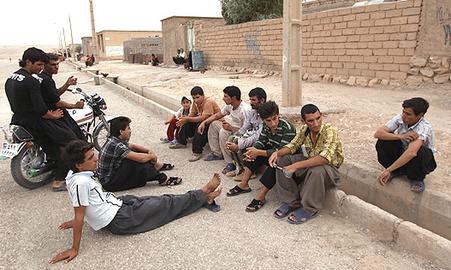The latest official statistics from Iran show that, during the Iranian calendar year 1397 (March 21, 2018 to March 20, 2019) there were 23.8 million employed people in the country. The nationwide rate of unemployment stood at 12 percent and the participation rate — the sum of all employed workers divided by the working-age population — reached 40.5 percent.
These figures show a relative improvement over the previous Iranian calendar year. A comparison of statistics for 1397 with those for 1396 shows that the unemployment rate has fallen by a tenth of one percent and the number of employed has risen by 434,000 [Persian PDF]. According to these statistics, the rate of economic participation has also increased by two-tenths of one percent and the number of economically active people has grown by around 485,000.
Once detailed data for 1397 becomes available, it will be possible to get a more accurate picture of part-time employment, what types of jobs people are employed in, and the age range of the people employed. Considering the fact that Iran’s economy has been going through a deep recession over the last year, which has especially affected the industrial sector, it is difficult to get an accurate and comprehensive picture of the current employment environment.
Employment and the Recession
At first glance, employment statistics and 2018-2019’s economic recession appear to be unrelated. But a close look at the figures reveals that the effects of US sanctions on Iran and the recession have yet to reach the job market. It is quite conceivable that in the coming months, the Iranian economy's service sector will show the impact of the recession, and this will reveal that the unemployment crisis has become worse.
A report published a few weeks ago by the Statistical Center of Iran shows that in the first nine months of 1397 (which began on March 21, 2018), the Iranian economy shrank by 3.8 percent [Persian link]. The highest level of recession was in the industrial sector, with a negative growth of 7.9 percent. In the same period, the agricultural sector witnessed a negative 2.1 percent growth and the service sector fell by 0.6 percent. These figures are largely the result of oil sanctions on Iran.
The latest reports by the Organization of Petroleum Exporting Countries (OPEC) shows that petroleum production in Iran has now fallen to around 2.7 million barrels per day, a decrease of about 25 percent. Since the price of petroleum has been relatively stable, this decline means a recession for the petroleum sector and associated industries. Without this fall in petroleum production, the nine-month negative growth would have been around 1.9 percent.
Nevertheless, the recession in the oil sector does not have a direct and immediate impact on employment. The government is the main employer in Iran’s petroleum sector and, as a result, these jobs enjoy relative security. But, as the recession in the petroleum sector continues, it will affect other sectors in the economy as well, directly and indirectly, including the service sector, which is the biggest (and most vulnerable) employment sector in Iran.
According to official statistics, the service sector currently represents half of the job market in Iran. Most jobs in the private sector fall into this category, from commercial and financial services to educational, medical and many other services. As a result, as the recession spreads and service sector jobs drop off, the first victims will be private sector employees.
In 1937, according to the Statistical Center of Iran, 86 percent of men and 77 percent of women in the workforce were employed in the private sector [Persian link]. This means that around 17 million men and 3.3 million women — more than 20 million in total — were employed in the private sector. Inevitably, during an economic crisis, these people are more vulnerable than public sector employees, and, as the effect of sanctions against Iran becomes more evident in the coming months, they are going to face difficult days.
Employment and Inflation
In addition, runaway inflation has sharply reduced Iranian households’ purchasing power. The latest inflation statistics for March 2019 show that the average costs of the family household have increased by more than 50 percent compared to the year before. The increase has been higher for poor and rural households. In such a situation, the natural response among people who are currently economically inactive, such as students or homemakers, is to enter the job market and look for work. But, with at least 12 percent unemployment, the Iranian job market already has difficulty accommodating new arrivals.
In the short term, it is likely that the increase in population will lead to an increase in the number of people in temporary and unstable jobs. But if the current economic conditions continue, Iran will gradually witness an increase in the rate of unemployment.
The Geography of Unemployment
It is also important to assess the geography of unemployment in Iran in 2018-2019. A comparison of the unemployment and economic participation rates in various provinces shows which provinces are more vulnerable to the looming further economic crisis.
According to the Statistical Center of Iran, in 2018-2019, the province of Kermanshah had the highest unemployment rate in the country, at 18.7 percent. Next came Khuzestan and Sistan and Baluchistan, both with around 16 percent unemployment.
It is worth noting that the province of Sistan and Baluchistan also has the lowest rate of economic participation. Only 33 percent of the total population of this province is old enough to be included in the figures for economic participation, but out of this, 16 percent of these people cannot find any job, even temporary jobs for a few hours a week. The economic participation rate in Khuzestan is also slightly lower than the national average, and in Kermanshah this number is only three percentage points higher than the national average.
Looking at these statistics alongside these provinces’ current situations and their vulnerability to economic, political and natural events — such as the recent floods in northern and western parts of Iran — it becomes clear that the vulnerability of these areas is much higher than the rest of Iran and the worsening economic crisis will create more turbulence in these provinces.
This is not to say that the rest of Iran is doing fine. With a population of 80 million, the rate of economic participation is only 40 percent and 12 percent of people are unemployed. This means that the situation in the particular provinces highlighted is truly critical.
Related Coverage:
Decline in Investment Across Iran After US Exit from the Nuclear Deal, April 27, 2019
Can Iran Survive Record Inflation?, February 25, 2019
Iran’s Unemployment Crisis: Only 11 Million Full-time Jobs, January 23, 2019
Would Shaving Off Zeros from the National Currency Help the Iranian Economy?, January 15, 2019
Could a 20% Salary Increase Help State Employees?, December 5, 2018
Iran Rushing Toward 30 Percent Inflation, November 27, 2018
, October 30, 2018
How did Countries Deal with Iran During Previous Sanctions?, August 7, 2018
Expert Warns “Iran’s Economy is in a Death Spiral,” April 26, 2018
visit the accountability section
In this section of Iran Wire, you can contact the officials and launch your campaign for various problems

























comments